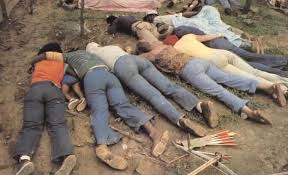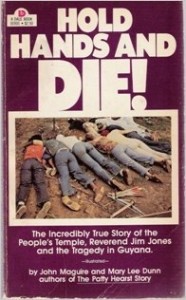 Some of the questions that have haunted the Jonestown story since the very first week are in relation to the position of the bodies. In this discussion, we have been hindered by the fact that the most publicized press pictures of the bodies only show a very small proportion of the whole scene.
Some of the questions that have haunted the Jonestown story since the very first week are in relation to the position of the bodies. In this discussion, we have been hindered by the fact that the most publicized press pictures of the bodies only show a very small proportion of the whole scene.
The most familiar aerial shots we have all seen of the carnage show some kind of order, in that the ground is almost completely covered with bodies which seem to follow the contours of the landscape, i.e. not lying across roads and mostly parallel to fences. This would suggest normal human behavior: we tend to align ourselves when we can, don’t we?
But I have also seen some very disturbing pictures which clearly defy the peaceful image of the family group with the child’s feet sticking out. A man on his back with contorted limps, an infant alone on its side, not quite next to the grown man close by, to name a few. These are not bodies at rest.
 And so my question is this: why did the press choose the “peaceful family photos” to depict the event, when at the same time the story they were telling was of a brainwashed/ insane cult? They could have shown chaotic, shocking, grotesque pictures which would have fit with “our” understanding of them as different from us. Instead they chose the pictures we could identify ourselves with – parents cradling their children and lovers embracing each other – in short, the pictures that became part of the myth of Jonestown, as reflected in the title of the quickie paperback, Hold Hands and Die.
And so my question is this: why did the press choose the “peaceful family photos” to depict the event, when at the same time the story they were telling was of a brainwashed/ insane cult? They could have shown chaotic, shocking, grotesque pictures which would have fit with “our” understanding of them as different from us. Instead they chose the pictures we could identify ourselves with – parents cradling their children and lovers embracing each other – in short, the pictures that became part of the myth of Jonestown, as reflected in the title of the quickie paperback, Hold Hands and Die.
I believe someone with knowledge of how death is perceived and portrayed should discuss what that means. Perhaps the photographs from Jonestown should be compared to how Holocaust victims in World War II were portrayed. They were victims, in stacks, stripped of their agency, as opposed to the portrayal of Jonestown, in which people went to their death in an orderly and compliant fashion, their agency intact. They apparently chose to lie down in certain ways and with certain people. They weren’t done to, according to the pictures. They did. That could explain why we think the entire scene was “neat” and in rows: it is what we have seen in the pictures. It has become part of the myth.
Survivors, however, say that things weren’t quite as orderly as they appear on the tape and as some of the pictures would have us believe.
Tim Carter, who not only survived the deaths in Jonestown but who had to return to help with body identification, once told me that some of the bodies looked like they had been arranged almost like in tableaus after death. He speculated that it could have been part of the great message to send to the world – “we died peacefully and in unity” – or as a final act of kindness by other loved ones. The latter would explain the blankets. Someone tucked in his or her loved ones after they had died. For a lack of a better explanation, we even toyed with the idea that the press could have done it themselves, although we both knew that was unlikely if not impossible.
But the blankets, the tableaus, the embraces don’t explain the rows. Personally I don’t believe they were arranged after death. Who would have the strength and energy to move around what is literally dead weight? It would be like playing a horrible puzzle game to free space to move someone into a new wanted position. And how long would it take?
People have also suggested that the people of Jonestown took the poison and then proceeded to lay themselves in rows where they died. I don’t know if that is possible. I can see it happening from an overdose of sedatives, but I have been told that there is nothing relaxing or soothing during death from cyanide poisoning, that to the contrary, it involves violent cramps and spasms. This would seem to contradict the theory of people dying in rows. This of course also means that we accept the fact that people as a general rule were in neat rows. I am not sure they were, I think those were just the photos that we saw.
I wonder if it is possible to ask a forensic pathologist who knows how to examine crime scene photos whether an analysis of the aerial shot can establish which areas of the death scene seem to be “order,” which seem to be in chaos, and what the relationship between them is. Or if perhaps a sketch artist could outline the contours of the individual bodies to give us a clearer picture of their positions. My feeling is that such a reproduction of the death scene would challenge our perception of that final day; that we would find general chaos with bits of order – either for practical reasons (space, topography) or as small acts of kindness – and that the order was exaggerated, for whatever reason, by the press. But one thing is feeling, knowing is quite another thing. I hope research, with time, will bring us from one to the other.
(Rikke Wettendorff is the co-editor of the jonestown report. Her articles from previous editions appear here. She can be reached at rikke@wettendorff.net.)